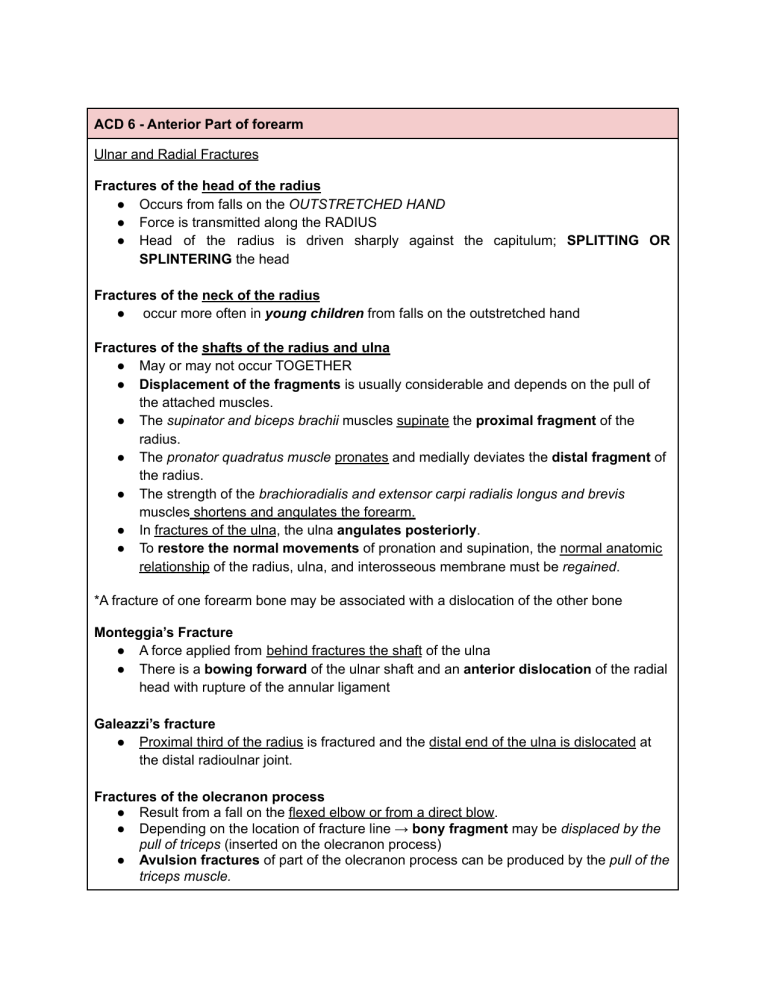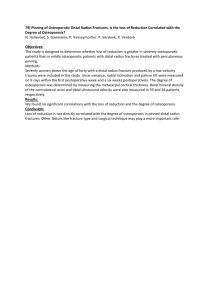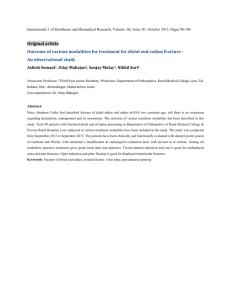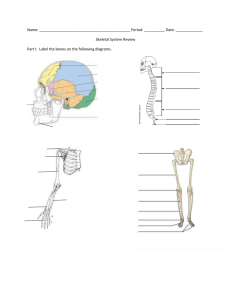
ACD 6 - Anterior Part of forearm Ulnar and Radial Fractures Fractures of the head of the radius ● Occurs from falls on the OUTSTRETCHED HAND ● Force is transmitted along the RADIUS ● Head of the radius is driven sharply against the capitulum; SPLITTING OR SPLINTERING the head Fractures of the neck of the radius ● occur more often in young children from falls on the outstretched hand Fractures of the shafts of the radius and ulna ● May or may not occur TOGETHER ● Displacement of the fragments is usually considerable and depends on the pull of the attached muscles. ● The supinator and biceps brachii muscles supinate the proximal fragment of the radius. ● The pronator quadratus muscle pronates and medially deviates the distal fragment of the radius. ● The strength of the brachioradialis and extensor carpi radialis longus and brevis muscles shortens and angulates the forearm. ● In fractures of the ulna, the ulna angulates posteriorly. ● To restore the normal movements of pronation and supination, the normal anatomic relationship of the radius, ulna, and interosseous membrane must be regained. *A fracture of one forearm bone may be associated with a dislocation of the other bone Monteggia’s Fracture ● A force applied from behind fractures the shaft of the ulna ● There is a bowing forward of the ulnar shaft and an anterior dislocation of the radial head with rupture of the annular ligament Galeazzi’s fracture ● Proximal third of the radius is fractured and the distal end of the ulna is dislocated at the distal radioulnar joint. Fractures of the olecranon process ● Result from a fall on the flexed elbow or from a direct blow. ● Depending on the location of fracture line → bony fragment may be displaced by the pull of triceps (inserted on the olecranon process) ● Avulsion fractures of part of the olecranon process can be produced by the pull of the triceps muscle. ● Good functional return after any of these fractures depends on the accurate anatomic reduction of the fragment. Colles’ fracture ● Fracture of the distal end of the radius from a fall on the outstretched hand ● Commonly occurs in patients older than 50 years ● Force drives the distal fragment posteriorly & superiorly and the distal articular surface is inclined posteriorly ● Posterior displacement → Posterior bump (dinner-fork deformity) ○ The forearm and wrist resemble the shape of that eating utensil ● Failure to restore the distal articular surface to its normal position → severely limit the range of flexion of the wrist joint Smith’s Fracture ● Fracture of the distal end of the radius ● Occurs from a fall on the back of the hand ● Reverse COLLES’ FRACTURE (distal fragment is displaced anteriorly) Olecranon Bursitis ● A small subcutaneous bursa is present over the olecranon process of the ulna ● Repeated wear or trauma → produces chronic bursitis Hand Bone Injury Fracture of the scaphoid bone ● Common in young adults ● Unless treated effectively → fragments will not unite & permanent weakness and pain of the wrist with subsequent development of osteoarthritis ● Fracture line → narrowest part of the line (bathed in synovial fluid) ● Blood vessel → confined to its distal end ● Fracture deprives the proximal fragment of its arterial supply (avascular necrosis) ● Deep tenderness in the anatomic snuffbox after a fall on the outstretched hand in a young adult is suspicious for a fractured scaphoid. Dislocation of the lunate bone ● Occurs in young adults who fall on the outstretched hand in a way that causes hyperextension of the wrist joint. ● Involvement of the median nerve is common Fractures of the metacarpal bones ● Result of direct violence (clenched fist striking a hard object) ● Fractures are always angulated dorsally. ● The “boxer’s fracture” commonly produces an oblique fracture of the neck of the fifth ● and sometimes the fourth metacarpal bones. The distal fragment is commonly displaced proximally, thus shortening the finger posteriorly. Bennett’s fracture ● Fracture of the base of the metacarpal of the thumb caused when violence is applied along the long axis of the thumb or the thumb is forcefully abducted. ● The fracture is oblique and enters the carpometacarpal joint of the thumb, causing joint instability. Fractures of the phalanges → common and usually follow direct injury. Carpal Tunnel Syndrome ● Carpal tunnel is tightly packed with the long flexor tendons of the fingers, with their surrounding synovial sheaths, and with the median nerve ● Any condition that significantly decreases the size of the carpal tunnel and compresses its contents is a carpal tunnel syndrome. Dupuytren Contracture ● A localized thickening and contracture of the palmar aponeurosis, which limits hand function and may eventually disable the hand. ● It commonly starts near the root of the ring finger and draws that finger into the palm, flexing it at the metacarpophalangeal joint. ● Later, the condition involves the little finger in the same manner. ● In long-standing cases, the pull on the fibrous sheaths of these fingers results in flexion of the proximal interphalangeal joints. ● The distal interphalangeal joints are not involved and are actually extended by the pressure of the fingers against the palm. *Surgical division of the fibrous bands followed by physiotherapy of the hand (TREATMENT) Fascial Spaces of Palm and Infection ● The fascial spaces of the palm are clinically important ○ They can become infected and distended with pus as a result of the spread of infection in acute suppurative tenosynovitis. ○ Rarely, they can become infected after penetrating wounds such as falling on a dirty nail Pulp Space Infection (Felon) ● Closed fascial compartment situated anterior to the terminal phalanx of each finger ● Infection of such a space is common and serious ● Occurs most often in the thumb and index finger. ● Bacteria are usually introduced into the space by pinpricks or sewing needles ○ Each space is subdivided into smaller compartments by fibrous septa ○ Accumulation of inflammatory exudate within these compartments causes the pressure in the pulp space to quickly rise. ○ infection is left without decompression, infection of the terminal phalanx occurs. ○ In children, the blood supply to the diaphysis of the phalanx passes through the pulp space, and pressure on the blood vessels could result in necrosis of the diaphysis. ○ The proximally located epiphysis of this bone is saved because it receives its arterial supply just proximal to the pulp space. *The close relationship of the proximal end of the pulp space to the digital synovial sheath accounts for the involvement of the sheath in the infectious process when the pulp space infection has been neglected. Forearm Compartment Syndrome ● Forearm compartments are tightly packed spaces with very little extra room. ● Any edema can cause secondary compression of the blood vessels ○ Veins are first affected and later the arteries. ● Soft tissue injury is a common cause and early diagnosis is critical. ● Early Signs: ○ Altered skin sensation → ischemia of the sensory nerves ○ ○ ○ ○ ○ Pain disproportionate to any injury → pressure on nerves within the compartment Pain on passive stretching of muscles → muscle ischemia Tenderness of the skin over the compartment → edema Absence of capillary refill in the nail beds → pressure on the arteries Deep fascia must be incised surgically to decompress the affected compartment. A delay of as little as 4 hours can cause irreversible damage to the muscles Volkmann’s Ischemic Contracture ● A contracture of the muscles of the forearm → commonly follows fractures of the distal end of the humerus or fractures of the radius & ulna ● In this syndrome, a localized segment of the brachial artery goes into spasm, reducing the arterial flow to the flexor and the extensor muscles so that they undergo ischemic necrosis. ● The flexor muscles are larger than the extensor muscles; therefore the ones mainly affected. ● The muscles are replaced by fibrous tissue (contracts) → deformity. ● An overtight cast usually causes the arterial spasm; the fracture itself may be responsible. ● The deformity can be explained only by understanding the anatomy of the region. Three types of deformity exist: ○ The long flexor muscles of the carpus and fingers are more contracted than the extensor muscles, and the wrist joint is flexed; the fingers are extended. If the wrist joint is extended passively, the fingers become flexed. ○ The long extensor muscles to the fingers, which are inserted into the extensor expansion that is attached to the proximal phalanx, are greatly contracted; the metacarpophalangeal joints and the wrist joint are extended, and the interphalangeal joints of the fingers are flexed. ○ Both the flexor and extensor muscles of the forearm are contracted. The wrist joint is flexed, the metacarpophalangeal joints are extended, and the interphalangeal joints are flexed. Absent Palmaris Longus ● Palmaris longus muscle may be absent on one or both sides of the forearm in about 10% of people. ● Others show variation in form (centrally or distally placed muscle belly in the place of a proximal one) ● Muscle is relatively weak, its absence produces no disability. Tennis Elbow ● A partial tearing or degeneration of the origin of the superficial extensor muscles from the lateral epicondyle of the humerus ● Characterized by pain and tenderness over the lateral epicondyle of the humerus with pain radiating down the lateral side of the forearm ● Common in tennis players and violinists. Stenosing Synovitis of Abductor Pollicis Longus and Extensor Pollicis Brevis Tendons ● Result of repeated friction between these tendons and the styloid process of the radius → edematous and swell. ● Fibrosis of the synovial sheath produces a condition known as stenosing tenosynovitis in which movement of the tendons becomes restricted. ● Advanced cases require surgical incision along the constricting sheath. Extensor Pollicis Longus Tendon Rupture ● Rupture of this tendon → occurs after fracture of the distal third of the radius. ● Roughening of the dorsal tubercle of the radius by the fracture line can cause excessive friction on the tendon → rupture ● Rheumatoid arthritis can also cause rupture of this tendon. Tenosynovitis of Flexor Tendon Synovial Sheaths ● Tenosynovitis is an infection of a synovial sheath ● Most commonly results from the introduction of bacteria into a sheath through a small penetrating wound ● Rarely, the sheath may become infected by extension of a pulp space infection. Infection of a digital sheath results in distention of the sheath with pus ● The finger is held semiflexed and is swollen. ● Any attempt to extend the finger is accompanied by extreme pain → distended sheath is stretched. ● As the inflammatory process continues pressure within the sheath rises and may compress the blood supply to the tendons → travel in the vincula longa and brevia ● Rupture or later severe scarring of the tendons may follow. ● Further increase in pressure can cause the sheath to rupture at its proximal end ● Anatomically, the digital sheath of the index finger → thenar space, whereas that of the ring finger → midpalmar space. ● Sheath for the middle finger is related to both the thenar and midpalmar spaces ● These relationships explain how infection can extend from the digital synovial sheaths and involve the palmar fascial spaces. Space of Parona ● Fascial space in the forearm ● Infection of the digital sheaths of the little finger and thumb ● Ulnar and Radial bursae are quickly involved ● Infection be neglected = pus may burst through the proximal ends of bursae and enter fascial space of the forearm between the flexor digitorum profundus superficially and the pronator quadratus and the interosseous membrane deeply Mallet Finger ● Avulsion of the insertion of one of the extensor tendons into the distal phalanges ● Occur if the distal phalanx is forcibly flexed when the extensor tendon is taut ● The last 20° of active extension is lost resulting in a condition known as mallet finger or baseball finger Boutonnière Deformity ● Avulsion of the central slip of the extensor tendon proximal to its insertion into the base of the middle phalanx results in a characteristic deformity Anatomic Snuffbox ● A small triangular skin depression ○ Posterolateral → wrist ○ Medially → tendon of the extensor pollicis longus ○ Laterally → tendons of the abductor pollicis longus and extensor pollicis brevis ● Its clinical importance lies in the fact that the scaphoid bone is most easily palpated here and that the pulsations of the radial artery can be felt here.







